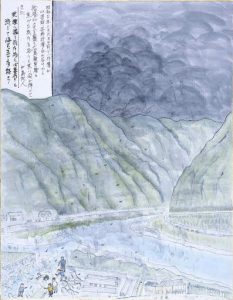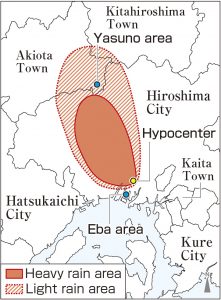“Black rain” exhibit to be displayed at Hiroshima Peace Memorial Museum starting February 27
Feb. 24, 2021
by Kyosuke Mizukawa, Staff Writer
Drawings of black rain falling after the atomic bombing of Hiroshima will be displayed in the main building of the Hiroshima Peace Memorial Museum starting February 27. The “A-bomb drawings” depict black rain falling outside the area within which people have been designated as eligible for relief from Japan’s national government. In a class action lawsuit involving the issue of black rain, the Hiroshima District Court ruled that all 84 plaintiffs, who were caught in the black rain outside the designated area, had the right to receive an A-bomb Survivor’s Certificate, and now the national government is moving ahead with its reassessment of the boundaries. The Peace Memorial Museum has decided to exhibit the black-rain artworks as a theme of keen public interest.
The new exhibit is one facet of a regular change in permanent exhibits. The drawings will be shown in the area called “Emotion Carried by the Brush,” in which original pieces of art by those who experienced the atomic bombing are to be displayed. Six drawings depicting black rain falling outside the area for relief measures will be introduced in the exhibit.
The “heavy rain area,” designated by the national government on which black rain with radioactive particles fell, constitutes an oval shape stretching northwest from the hypocenter and measuring about 19 kilometers in length and 11 kilometers in width. People within the boundaries are eligible to receive government aid. The boundaries were drawn based on the so-called “Uda rain area,” demarcated after a survey conducted by Michitaka Uda and other technicians at the Hiroshima District Meteorological Observatory during August–December 1945. The Peace Memorial Museum carefully reexamined more than 150 paintings and drawings involving black rain among its collection and found that several were depictions of areas outside the boundaries.
One of the six drawings shows black rain falling in the village of Yasuno (now the town of Akiota, Hiroshima Prefecture) located about 20 kilometers northwest of the hypocenter. Akito Nakashima donated the image to the museum in 2002. Sixteen at the time of the atomic bombing, Mr. Nakashima described in writing the drawing in this way: “When I was picking up pieces of burned paper, black rain started to fall.” The village is in the designated “light rain area,” which is not covered by the national government’s relief measures. Some of the plaintiffs of the class action lawsuit are people who experienced the black rain there.
The museum’s display is to include two drawings of black rain falling in the Eba area of the city, which is in the southern part of Hiroshima and not included in the “Uda rain area.”
The Hiroshima District Court, in its ruling of July last year, pointed out the limitations of the survey conducted by Mr. Uda and others in the chaotic aftermath of the atomic bombing. While the national government, along with prefectural and city governments, filed an appeal against the decision, it began to hold meetings to reexamine the black rain boundaries in November last year. In the meetings, experts called on the government to utilize materials left by those who experienced the rain.
Ryo Koyama, a curator at the museum’s curatorial division, said, “I hope people will come to know these valuable ‘testimonies’ that speak to the fact that black rain fell over a wide area in and around the city.”
Keywords
Black rain lawsuits
Eighty-four men and women between their 70s and 90s living in the city of Hiroshima and the town of Akiota claimed that the rejections of their applications for Atomic Bomb Survivor’s Certificates were in violation of the law and filed lawsuits against the city and prefectural governments of Hiroshima, demanding that the rejections be overturned. In the lawsuits filed in and after November 2015, the plaintiffs contended that their applications were rejected because they lived outside the government-designated area designated for relief measures, even though their health had been damaged from exposure to the radioactive black rain after the atomic bombing. In July 2020, the Hiroshima District Court handed down a ruling and ordered that certificates be issued to all the plaintiffs. Currently, the national government provides relief only to those within the “heavy rain area.” If such individuals are diagnosed as having one or more of 11 diseases designated by the government, including cancer and cataracts, they are eligible to receive an Atomic Bomb Survivor’s Certificate and free medical care.
(Originally published on February 24, 2021)
Images of town of Akiota, outside of relief measures area, provide “valuable testimony”
Drawings of black rain falling after the atomic bombing of Hiroshima will be displayed in the main building of the Hiroshima Peace Memorial Museum starting February 27. The “A-bomb drawings” depict black rain falling outside the area within which people have been designated as eligible for relief from Japan’s national government. In a class action lawsuit involving the issue of black rain, the Hiroshima District Court ruled that all 84 plaintiffs, who were caught in the black rain outside the designated area, had the right to receive an A-bomb Survivor’s Certificate, and now the national government is moving ahead with its reassessment of the boundaries. The Peace Memorial Museum has decided to exhibit the black-rain artworks as a theme of keen public interest.
The new exhibit is one facet of a regular change in permanent exhibits. The drawings will be shown in the area called “Emotion Carried by the Brush,” in which original pieces of art by those who experienced the atomic bombing are to be displayed. Six drawings depicting black rain falling outside the area for relief measures will be introduced in the exhibit.
The “heavy rain area,” designated by the national government on which black rain with radioactive particles fell, constitutes an oval shape stretching northwest from the hypocenter and measuring about 19 kilometers in length and 11 kilometers in width. People within the boundaries are eligible to receive government aid. The boundaries were drawn based on the so-called “Uda rain area,” demarcated after a survey conducted by Michitaka Uda and other technicians at the Hiroshima District Meteorological Observatory during August–December 1945. The Peace Memorial Museum carefully reexamined more than 150 paintings and drawings involving black rain among its collection and found that several were depictions of areas outside the boundaries.
One of the six drawings shows black rain falling in the village of Yasuno (now the town of Akiota, Hiroshima Prefecture) located about 20 kilometers northwest of the hypocenter. Akito Nakashima donated the image to the museum in 2002. Sixteen at the time of the atomic bombing, Mr. Nakashima described in writing the drawing in this way: “When I was picking up pieces of burned paper, black rain started to fall.” The village is in the designated “light rain area,” which is not covered by the national government’s relief measures. Some of the plaintiffs of the class action lawsuit are people who experienced the black rain there.
The museum’s display is to include two drawings of black rain falling in the Eba area of the city, which is in the southern part of Hiroshima and not included in the “Uda rain area.”
The Hiroshima District Court, in its ruling of July last year, pointed out the limitations of the survey conducted by Mr. Uda and others in the chaotic aftermath of the atomic bombing. While the national government, along with prefectural and city governments, filed an appeal against the decision, it began to hold meetings to reexamine the black rain boundaries in November last year. In the meetings, experts called on the government to utilize materials left by those who experienced the rain.
Ryo Koyama, a curator at the museum’s curatorial division, said, “I hope people will come to know these valuable ‘testimonies’ that speak to the fact that black rain fell over a wide area in and around the city.”
Keywords
Black rain lawsuits
Eighty-four men and women between their 70s and 90s living in the city of Hiroshima and the town of Akiota claimed that the rejections of their applications for Atomic Bomb Survivor’s Certificates were in violation of the law and filed lawsuits against the city and prefectural governments of Hiroshima, demanding that the rejections be overturned. In the lawsuits filed in and after November 2015, the plaintiffs contended that their applications were rejected because they lived outside the government-designated area designated for relief measures, even though their health had been damaged from exposure to the radioactive black rain after the atomic bombing. In July 2020, the Hiroshima District Court handed down a ruling and ordered that certificates be issued to all the plaintiffs. Currently, the national government provides relief only to those within the “heavy rain area.” If such individuals are diagnosed as having one or more of 11 diseases designated by the government, including cancer and cataracts, they are eligible to receive an Atomic Bomb Survivor’s Certificate and free medical care.
(Originally published on February 24, 2021)









